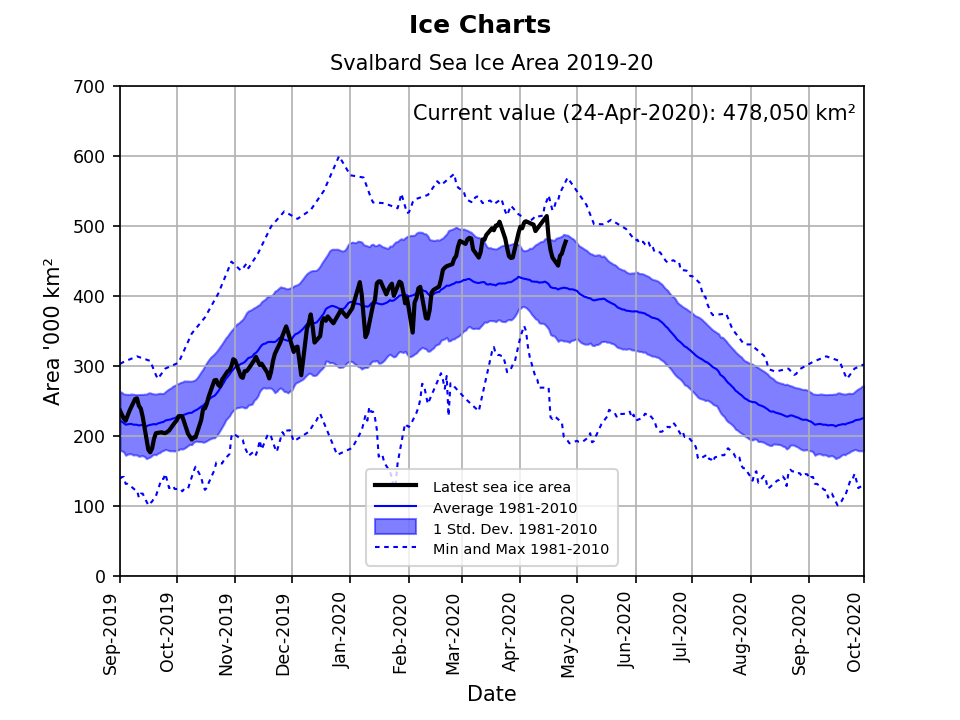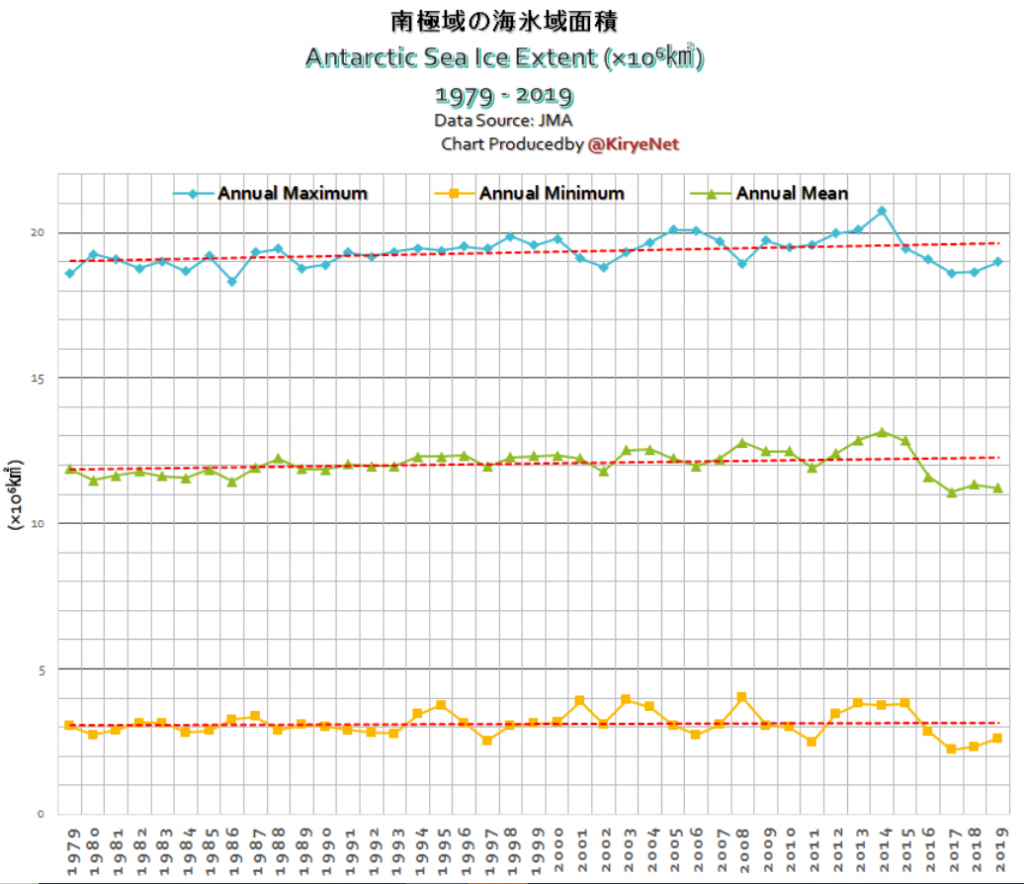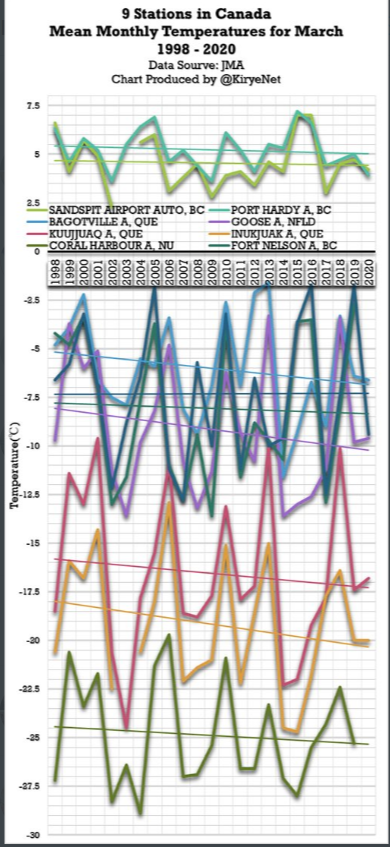Polar ice showing longer term stability. No basis for behind claims of a rapid melt.
By Kirye
and Pierre Gosselin
We keep hearing how the ice at the poles is supposedly disappearing rapidly, yet a look at the latest data show this is not the case. Polar ice has remained steady for the last decades.
Antarctic rebounding, trending upwards
Antarctic ice has in fact trended upwards since satellite measurement began 40 years ago.
Data: JMA.
A brand new article here describes how “Antarctica is not rapidly melting.”
Svalbard sea ice well above average
Die kalte Sonne site writes that something unexpected has happened in the Atlantic Ocean around Svalbard: The extent of sea ice there is far greater than the long-term average, as the following graph from the Norwegian Meteorological Institute shows:

What’s going on in the North Atlantic? How does all this ice fit with the earlier warnings that the sea ice is getting less and less?
German meteorologist Klaus Paetzold shows on his website many more interesting observations of ice and snow in the northern hemisphere.
Canadian winters lasting longer?
Though climate alarmists often claim Canada is warming twice as fast as the globe, the real, untampered data show that 5 of 9 stations in Canada – for which the JMA has near complete data – have had no warming trend in the month of March since 1986.
Source: JMA
Additionally, only one station shows a warming trend since 1998. Spring seems to be taking more time to arrive in Canada.
Summarizing: nothing dramatic is really happening at the earth’s poles.







[…] https://notrickszone.com/2020/04/28/polar-ice-surprises-svalbard-well-over-average-arctic-ice-remain… By P Gosselin Polar ice showing longer term stability. No basis for behind claims of a rapid melt. By Kirye and Pierre Gosselin We keep hearing how the ice at the poles is supposedly disappearing rapidly, yet a look at the latest data show this is not the case. 9 weitere Wörter […]
For several years, I have been unable to publish my study on climate change in mainstream journals. The message from editors is the story is too divergent from the conventional narrative on climate change. I have not received a single positive or negative comment from dozens of colleagues on the core methodology of the study. Perhaps, you might be interested in checking this story out. There are two possible stories. The scientific story and the censorship story. Three journal editors would not send the manuscript out for review. Is this anything?
For nearly 50 years, increasing intensity of currents in the central and eastern tropical Pacific Ocean have contributed to increased transient surface temperatures on earth. The highest global mean monthly surface temperature anomaly ever recorded of 1.111 degrees C was reached in 2016. Since then, temperatures overall have declined. A few more years of temperature data will be needed to confirm this as a long-term trend. The serendipity of the beginning of a manifold increase in the quantity of earth temperature data from earth orbiting satellites in 1979 coincides with the recognition of the beginning of nearly 50 years of increasing intensity of Pacific Ocean currents that culminated in 2016 with the largest intensity ever recorded. This unique period of 50 years of high intensity ocean currents may have led some scientists to conclude the earth is experiencing out-of-control global warming caused by anthropogenic emissions of pollutants.
Is this simply a unique coincidence? I do not think so. Earlier large intensity ocean events may not have been recognized due to the absence of satellite coverage over oceans. Never-the-less, the story of global warming has become a Eureka moment for climate scientists of the last generation.
The facts of a time-temperature series analysis of the earth over the last 170 years tell a much different story. From 1850 to the present, the noise-corrected, average warming of the surface of the earth has been less than 0.07 degrees C per decade, i.e., too small to measure. The earth is possibly not warming at all. This fact is indisputable evidence that global warming is not a threat to humanity. Now is not the time to embark on grandiose projects to save the planet. We have the time to get the science right before we bet the farm. Divert scarce resources to a real problem, the coronavirus.
Manuscript: https://www.uh.edu/nsm/earth-atmospheric/people/faculty/tom-bjorklund/170-years-of-earth-surface-temperature-data-show-no-evidence-of-significant-warming_april-2020.pdf
Just a year ago at this time weather predictions for the province of British Columbia in Canada were: hot and dry summer,lots of forest fires. In reality the summer of 2019 was cooler and soggy with almost no forest fires. Computer models failed miserably!
No surprise really!
It is of no surprise for many that as we progress through this current interglacial period that temperatures periodically rise and fall.
From about 1920 we’ve had about 80 years of moderate warming, (or 200 years of very slow warming out of the Little Ice Age) and given the cyclical nature of climate variations a downturn to cooler time appears to be coming evident. Much of the evidence shows-up in solar research — see https://notrickszone.com/category/solar-sciences/ and other short and long term temperature records and research — see https://notrickszone.com/category/cooling/
Kirye
Please keep writing your excellent articles. I would comment that the JMA appears to be, at present, remaining a scientific organisation.
The Australian BOM is a complete disgrace. They cannot even account for thermocouple errors and their blatant tampering with temperatures to suit a warmist outcome is totally unprofessional.
I work in the food industry and have issued warnings to personnel over adjustments to data, and a plant manager I worked with was dismissed over his tampering with aflatoxin readings for an export product. It is shameful that the BOM gets away with this and the Australian Environment Minister will not act.
[…] Fonte: No Tricks Zone […]
Let’s not be too happy about this. We don’t need shorter growing seasons with intense disease vectors.
Arctic sea is WELL BELOW the 40 year average. About a million sq kms below the mean. See for yourself.
https://sunshinehours.net/
What’s the point of looking at one small portion of the Arctic and implying that tells us anything about the whole?
It’s such patent disinformation.
thanks for this article
[…] Ref.: https://notrickszone.com/2020/04/28/polar-ice-surprises-svalbard-well-over-average-arctic-ice-remain… […]
[…] Polar Ice Surprises! Svalbard Well Over Average, Arctic Ice Remains Steady, Antarctic Ice Growing […]
Great article, I am glad I found your blog!